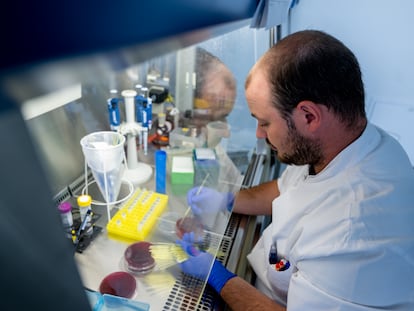Study suggests that rise in antibiotic resistance is linked to pollution
The research projects that 23% of deaths associated with this phenomenon could be prevented if WHO air quality guidelines were met

The rise of antibiotic-resistant microbes has put the world on edge: superbugs already kill more people than AIDS, malaria and some cancers. And the short- and medium-term outlook is bleak. The World Health Organization (WHO) considers this phenomenon to be “one of the biggest threats to global health” and points to the improper and excessive use of antibiotics as an accelerator of the problem. While the inappropriate consumption of these drugs garners most of the attention, it is not the only cause being studied. New research, published Monday in The Lancet Planetary Health, has also found a correlation between antibiotic resistance and pollution: the more air pollution, the more antibiotic resistance there is.
But the authors admit that their findings are only an association; causality cannot be established, and the exact mechanisms that explain this relationship are not clear. However, the researchers argue that reducing air pollution levels could help reduce antibiotic resistance and project that, if WHO air quality guidelines are met, a 17% reduction in antibiotic resistance could be achieved by 2050.
Humans are exposed to superbugs through food or direct contact with infectious sources, such as animals. They can also be infected through water, soil or air. “For example, resistant bacteria in hospitals or livestock could be transmitted to water treatment facilities or ecosystems, and even emitted from these environments into the atmosphere, [thereby] exposing humans [to it] through inhalation,” the authors say in the article.
Air is a vector for disseminating resistance to antibiotics. In this study, the researchers focus on one of the main pollutants, fine particulate matter PM2.5: “It has been shown that [these particles] contain various resistant bacteria and antibiotic resistance genes, which are transferred between environments and inhaled directly by humans, causing respiratory tract lesions and infections,” they explain.
Based on that premise, they analyzed available data from 116 countries between 2000 and 2018 — all told, they studied nine pathogens and 43 drugs — and found that air pollution levels correlate with increased antibiotic resistance. For example, a 1% increase in PM2.5 was associated with a 1.49% increase in resistances of Klebsiella pneumoniae bacteria to carbapenems, a type of broad-spectrum antibiotic. “Globally, a 10% increase in annual PM2.5 could lead to a 1.1% increase in aggregate antibiotic resistance and 43,654 premature deaths attributable to antibiotic resistance,” they state in the article. The research concluded that antibiotic resistance stemming from PM2.5 fine particulate matter caused about 480,000 premature deaths worldwide in 2018.
The main mechanism is the high PM2.5 concentration, which carries more antibiotic-resistant bacteria and genesZhenchao Zhou, Zhejiang University
The authors also found regional differences. Africa and Asia are the areas where the increases in PM2.5 could lead to the greatest increase in antibiotic resistance. In Saudi Arabia, for example, the researchers estimate that a 10% increase in PM2.5 would mean a 3% rise in bacterial resistance.
The researchers believe that reducing air pollution can have a double benefit because it can also prevent poor air quality’s harmful effects. The research modeled several future scenarios based on the fluctuation of several variables, such as air quality, healthcare spending and antibiotic use. The study concluded that, if nothing is done in the coming decades (through 2050), antibiotic resistance will increase by 17%, and deaths attributable to this cause will rise by more than 56% worldwide, especially in sub-Saharan Africa. However, if PM2.5 can be controlled to 5 μg/m³— the threshold recommended by the WHO — global antibiotic resistance could be reduced by 16.8%, preventing 23.4% of the deaths attributable to this phenomenon in 2050.
The mechanism is unclear
The researchers concede the limitations of their study. That includes the data with which they worked, as certain countries did not provide all the necessary information. These shortcomings may influence the study’s final results. The researchers also state that there may be other factors that are causing antibiotic resistance: “Additional social, economic and environmental factors — such as food intake, use of veterinary antibiotics, exposure to other contaminants, extreme environmental events, habits and customs — should be introduced to comprehensively assess [their] association with antibiotic resistance,” the article says.
They also note that the study’s other major open question is that “the underlying mechanism of air pollutants affecting antibiotic resistance is still unclear, and additional medical evidence is still needed to verify that information.” The study’s lead author Zhenchao Zhou, a researcher at Zhejiang University’s School of Environmental and Resource Sciences in China, acknowledges the study’s limitations. In an email response, he specifies that “we all know that correlation does not represent causation, and for the sake of rigorous science, we say ‘may be linked.’ In our analysis, we could say that the correlation between air pollution and antibiotic resistance is strong and significant.”
It was already known that elements related to antibiotic resistance could travel in airborne particles, but this is an interesting messageJuan Pablo Horcajada, Hospital del Mar in Barcelona, Spain
In regard to how the relationship between particulate pollutants and antibiotic resistance can be explained, Zhou says that the “exact mechanism is not clear.” But he adds that, “according to reports in the existing literature, the main mechanism is that the high concentration of PM2.5 carries more bacteria and antibiotic-resistant genes, and direct exposure to these substances can lead to increased antibiotic resistance in the population.”
Zhou also points out that it has already been shown that PM2.5 particles “could increase cell membrane permeability to enhance horizontal gene transfer’s efficiency, accelerating the evolution and exchange of antibiotic resistance elements in bacterial pathogens.”
More questions than answers
He goes on to say that five years ago, he and his team collected a hundred PM2.5 air samples from hospitals, farms and cities, and sputum samples from human airways. “Surprisingly,” he notes, they found “that the abundance of antibiotic resistance genes in PM2.5 air was very high.” Those airborne antibiotic resistance genes, he explains, were going to be directly exposed to the human body. “We found that, together, outdoor and indoor PM2.5 particles contributed to 7% of antibiotic resistance genes in the airways of hospital patients, suggesting an important exchange between air and human commensals. So, we hypothesized that PM2.5 would affect antibiotic resistance, but at the time we didn’t know what kind of impact. Now, using big global data, we [can] confirm that PM2.5 has a significant impact on antibiotic resistance,” he says.
Juan Pablo Horcajada, the director of the Infectious Diseases Service at Hospital del Mar in Barcelona, Spain, calls this research “innovative and provocative,” although he observes that it involves “data correlations and deductions from very different databases.” He adds “that it was already known that elements related to antibiotic resistance could travel in airborne particles, but this is an interesting message,” he says. The specialist in infectious diseases argues that, if a causal relationship between contamination and antibiotic resistance is confirmed, the impact on the future of resistant microbes may be even greater than expected. “Antimicrobial resistance worries us a lot, and that concern is growing. We no longer know which antibiotics to use to treat certain bacteria. It is of great concern because [we see this phenomenon]… in hospitals, primary care and veterinary medicine,” he says.
Kevin McConway, Professor Emeritus of Applied Statistics at the UK’s Open University, tells Science Media Centre that “interpreting [these results] requires a great deal of caution.” He notes that while the authors found “interesting correlations and associations, questions remain about cause and effect.” McConway, who was not involved in the research, points out that the data come from countries as a whole, but there can be a lot of variability in air quality, for example, within a single region, and the average results may not represent what is happening in general.
The expert further advises that “it is likely that there are other possible confounders for which they could not collect any data, and it is still possible that there are confounders at work that are involved in the causality of a country’s level of antibiotic resistance.” He stresses that “overall, this observational data analysis and modeling research indicate that it may well be worth looking further into the role of air pollution in relation to antibiotic resistance, but at this stage there remains a great deal of uncertainty about what is actually happening. I would say that the new research raises more questions than it answers.”
Sign up for our weekly newsletter to get more English-language news coverage from EL PAÍS USA Edition
Tu suscripción se está usando en otro dispositivo
¿Quieres añadir otro usuario a tu suscripción?
Si continúas leyendo en este dispositivo, no se podrá leer en el otro.
FlechaTu suscripción se está usando en otro dispositivo y solo puedes acceder a EL PAÍS desde un dispositivo a la vez.
Si quieres compartir tu cuenta, cambia tu suscripción a la modalidad Premium, así podrás añadir otro usuario. Cada uno accederá con su propia cuenta de email, lo que os permitirá personalizar vuestra experiencia en EL PAÍS.
¿Tienes una suscripción de empresa? Accede aquí para contratar más cuentas.
En el caso de no saber quién está usando tu cuenta, te recomendamos cambiar tu contraseña aquí.
Si decides continuar compartiendo tu cuenta, este mensaje se mostrará en tu dispositivo y en el de la otra persona que está usando tu cuenta de forma indefinida, afectando a tu experiencia de lectura. Puedes consultar aquí los términos y condiciones de la suscripción digital.
More information
Archived In
Últimas noticias
Most viewed
- Alain Aspect, Nobel laureate in physics: ‘Einstein was so smart that he would have had to recognize quantum entanglement’
- Mexico’s missing people crisis casts a shadow over World Cup venue
- Why oil has been at the center of Venezuela-US conflicts for decades
- Trump clarifies who is ultimately in charge in Venezuela: ‘Me’
- Mexico seeks to shore up its defenses following US incursion in Venezuela











































